engine Citroen DS5 HYBRID4 RHD 2011.5 1.G Owner's Guide
[x] Cancel search | Manufacturer: CITROEN, Model Year: 2011.5, Model line: DS5 HYBRID4 RHD, Model: Citroen DS5 HYBRID4 RHD 2011.5 1.GPages: 358, PDF Size: 10.77 MB
Page 45 of 358
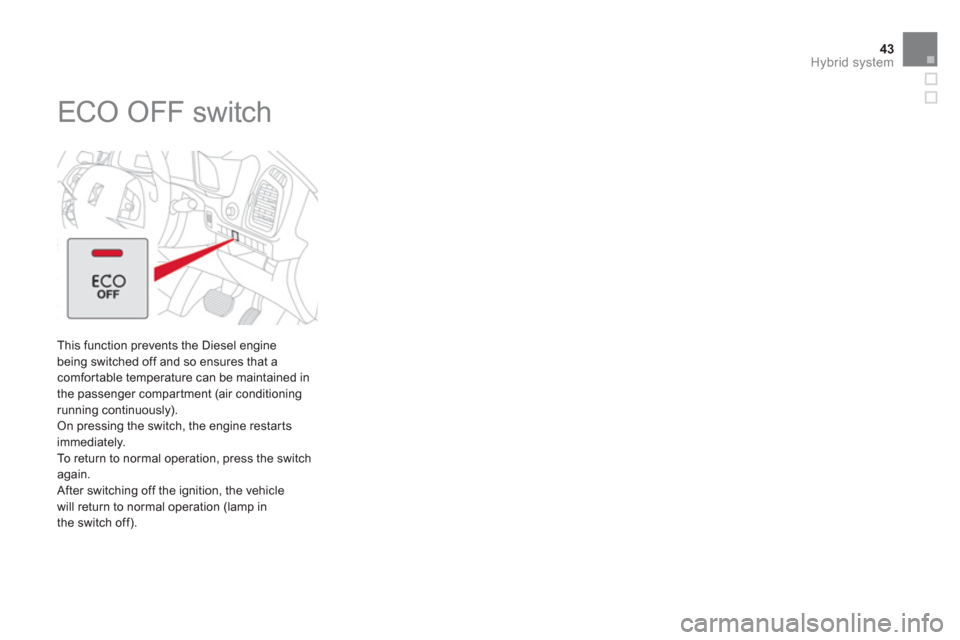
43Hybrid system
ECO OFF switch
This function prevents the Diesel engine
being switched off and so ensures that a comfor table temperature can be maintained in
the passenger compar tment (air conditioning
running continuously).
On pressing the switch, the engine restar ts
immediately.
To return to normal operation, press the switch
a
gain.
After switching off the ignition, the vehicle
will return to normal operation (lamp in
the switch off).
Page 46 of 358

Eco-driving
Eco-driving is a range of everyday practices that allow the motorist to optimise their fuel consumption and CO2emissions.
Optimise the use of your
gearbox
Use automatic mode Aas much as possible
as this optimises gear changes to suit the circumstances.
Drive smoothly
Maintain a safe distance between vehicles, use engine braking rather than the brake pedal, and press the accelerator progressively. These practices contribute towards a reduction in fuel consumption and CO2 emissions and also helps reduce
the background traffic noise.
If your vehicle has cruise control, make use of the system at speeds above 25 mph (40 km/h) when the traffic is flowing well.
Before moving off, if the passenger compartment is too warm, ventilate it byopening the windows and air vents before using the air conditioning.
Above 30 mph (50 km/h), close the windows and leave the air vents open.
Remember to make use of equipment that canhelp keep the temperature in the passenger compartment down (sun roof and windowblinds...). Switch off the air conditioning, unless it has automatic digital regulation, as soon as thedesired temperature is attained. Switch off the demisting and defrostingcontrols, if not automatic.
Switch off the heated seat as soon as possible.
Switch off the headlamps and front foglampswhen the level of light does not requiretheir use.
Avoid running the Diesel engine when stationary, par ticularly in winter; your vehicle will warm up much faster while driving.
As a passenger, if you avoid connecting your multimedia devices (film, music, videogame...), you will contribute towards limitingthe consumption of electrical energy, and soof fuel.
Disconnect your por table devices beforeleaving the vehicle.
Control the use of your electrical equipment
Page 47 of 358
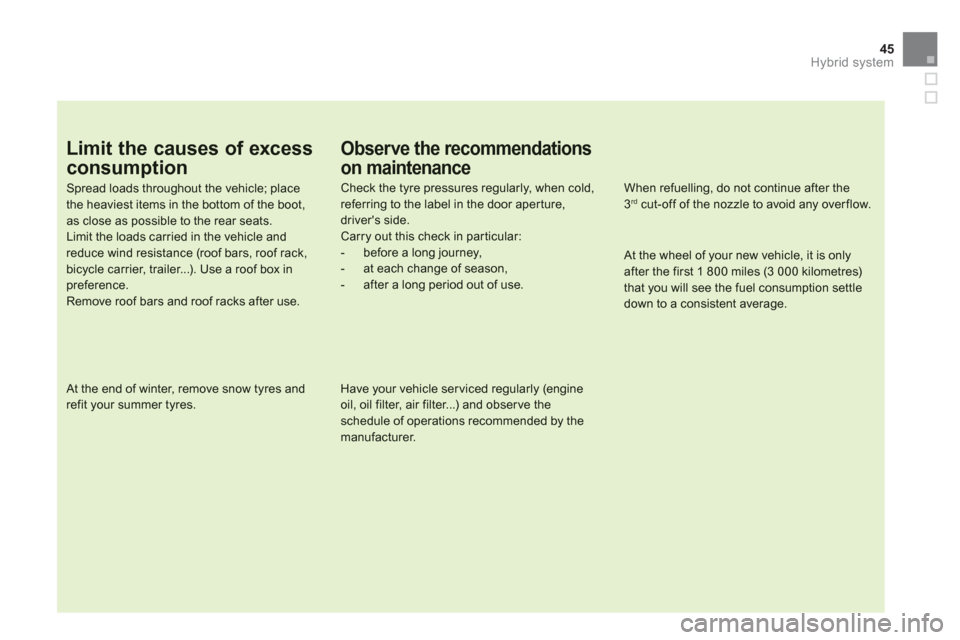
45
Hybrid system
Limit the causes of excess
consumption
Spread loads throughout the vehicle; place the heaviest items in the bottom of the boot,as close as possible to the rear seats.Limit the loads carried in the vehicle and reduce wind resistance (roof bars, roof rack, bicycle carrier, trailer...). Use a roof box inpreference.Remove roof bars and roof racks after use.
At the end of winter, remove snow tyres and refit your summer tyres.
Observe the recommendations
on maintenance
Check the tyre pressures regularly, when cold, referring to the label in the door aper ture, driver's side.Carry out this check in par ticular:- before a long journey,- at each change of season,- after a long period out of use.
Have your vehicle ser viced regularly (engine oil, oil filter, air filter...) and obser ve the schedule of operations recommended by the manufacturer.
When refuelling, do not continue after the3 rd
cut-off of the nozzle to avoid any over flow.
At the wheel of your new vehicle, it is only after the first 1 800 miles (3 000 kilometres) that you will see the fuel consumption settledown to a consistent average.
Page 48 of 358
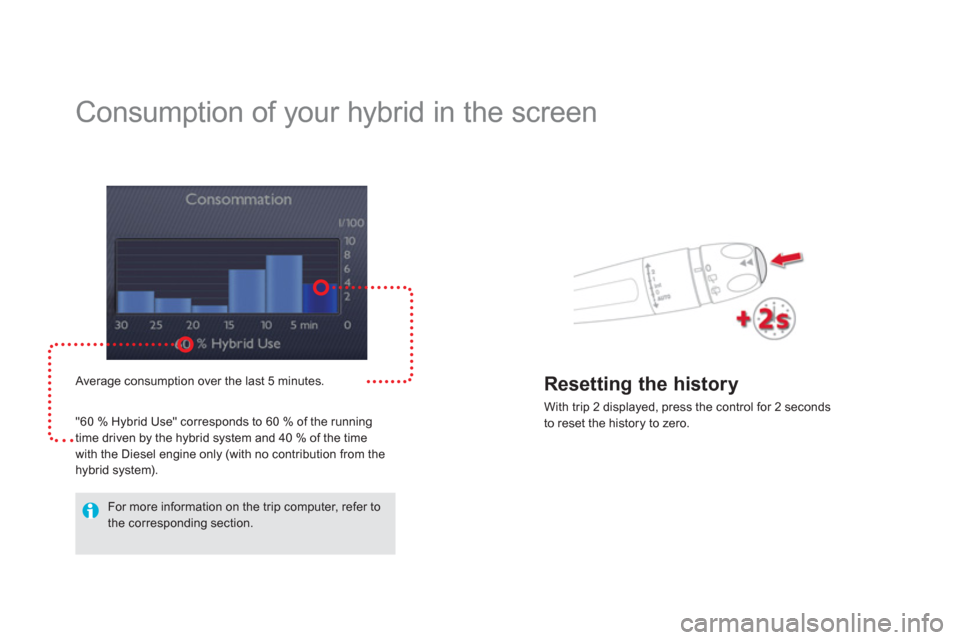
Consumption of your hybrid in the screen
Average consumption over the last 5 minutes.
"60 % H
ybrid Use" corresponds to 60 % of the running
time driven by the hybrid system and 40 % of the time
with the Diesel engine only (with no contribution from thehybrid system).
For more information on the trip computer, refer tothe corresponding section.
Resetting the history
With trip 2 displayed, press the control for 2 seconds
to reset the history to zero.
Page 49 of 358
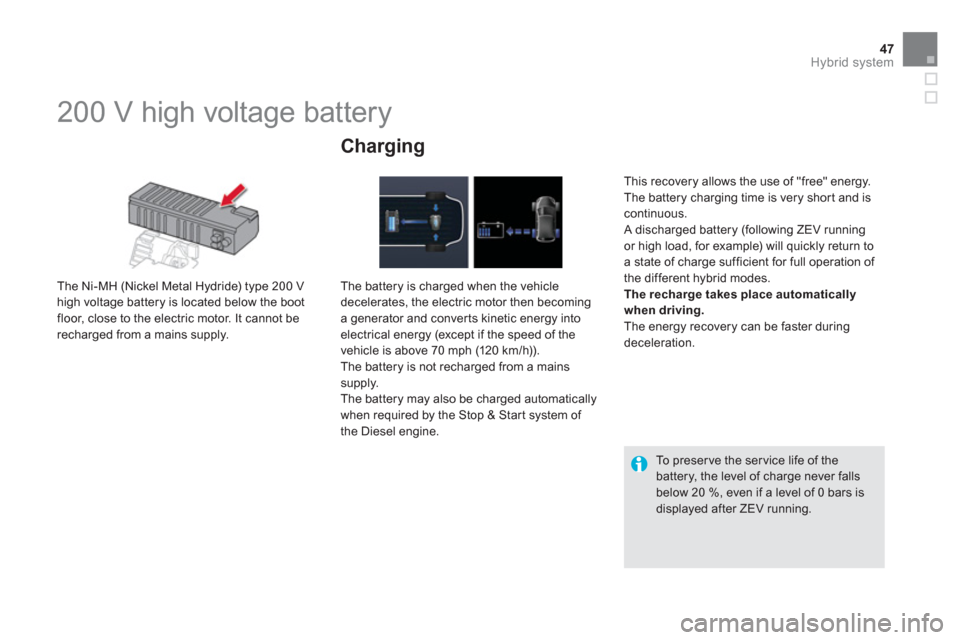
47Hybrid system
200 V high voltage battery
The Ni-MH (Nickel Metal Hydride) type 200 V high voltage battery is located below the boot
floor, close to the electric motor. It cannot be
recharged from a mains supply.
Charging
The battery is charged when the vehicle
decelerates, the electric motor then becominga generator and conver ts kinetic energy into
electrical energy (except if the speed of the
vehicle is above 70 mph (120 km/h)).
The battery is not recharged from a mains
supply.
The battery may also be charged automatically
when required by the Stop & Start system of
the Diesel engine.
This recover
y allows the use of "free" energy.
The battery charging time is very short and iscontinuous.
A discharged battery (following ZEV running or high load, for example) will quickly return to
a state of charge sufficient for full operation of
the different hybrid modes.
The recharge takes place automatically
when driving .
The energy recovery can be faster during deceleration.
To preser ve the ser vice life of thebattery, the level of charge never falls below 20 %, even if a level of 0 bars is displayed after ZEV running.
Page 52 of 358
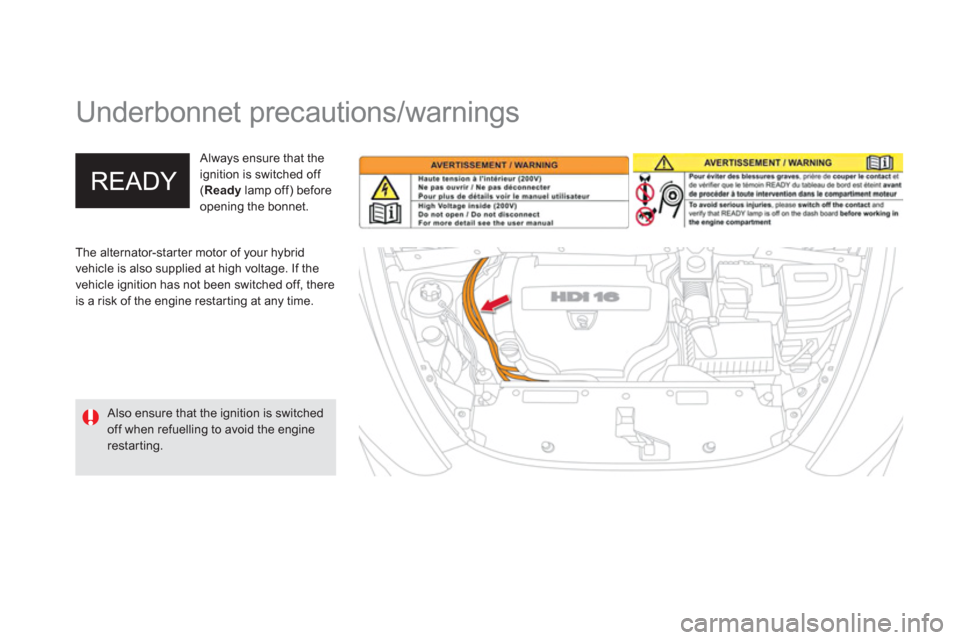
Underbonnet precautions/warnings
The alternator-star ter motor of your hybrid
vehicle is also supplied at high voltage. If the
vehicle ignition has not been switched off, there
is a risk of the engine restar ting at any time.
Alwa
ys ensure that theignition is switched off ( Readylamp off) before
opening the bonnet.
Also ensure that the ignition is switchedoff when refuelling to avoid the enginerestarting.
Page 56 of 358
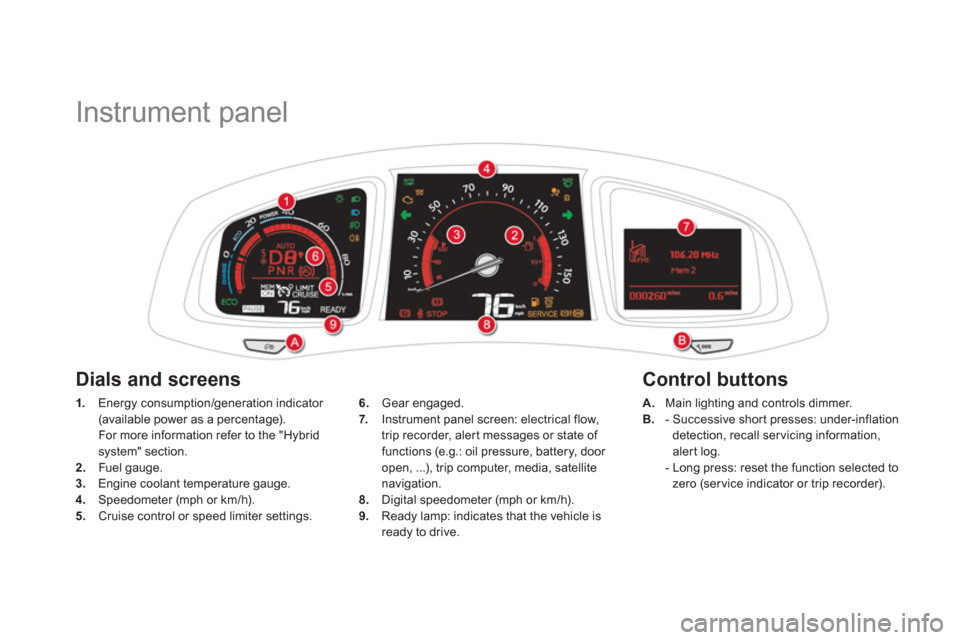
Instrument panel
1.
Energy consumption/generation indicator (available power as a percentage).
For more information refer to the "H
ybrid
system" section.2. Fuel gauge.3.Engine coolant temperature gauge. 4.
Speedometer (mph or km/h).5.
Cruise control or speed limiter settings.A
.Main lighting and controls dimmer.
B.- Successive shor t presses: under-inflation
detection, recall servicin
g information, alert log.
- Long press: reset the function selected to
zero (service indicator or trip recorder). 6
. Gear engaged.
7.Instrument panel screen: electrical flow,
trip recorder, aler t messa
ges or state of functions (e.g.: oil pressure, battery, door open, ...), trip computer, media, satellite
navigation.8. Digital speedometer (mph or km/h). 9.Ready lamp: indicates that the vehicle is
ready to drive.
Dials and screens
Control buttons
Page 57 of 358
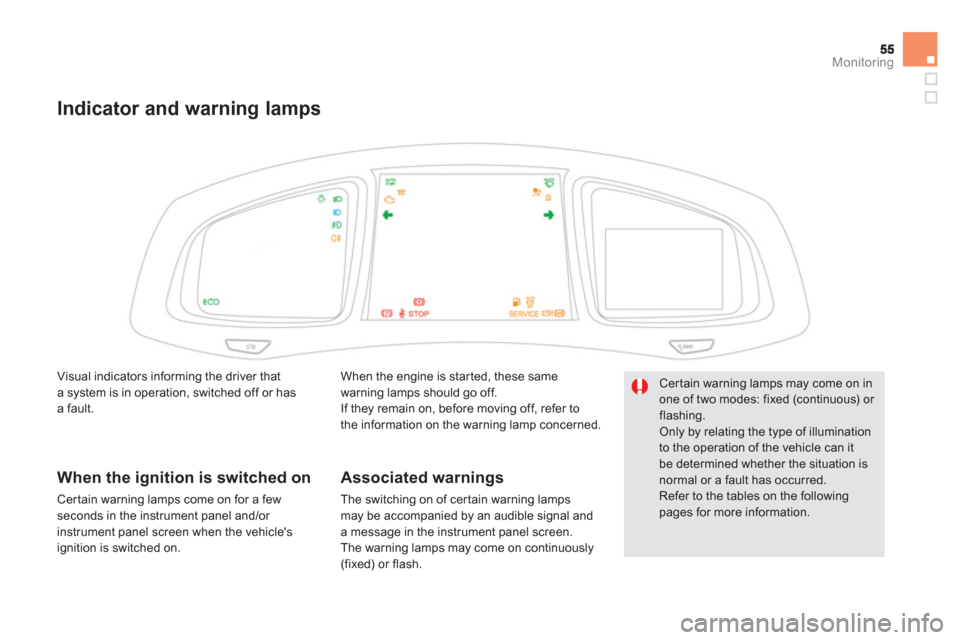
Monitoring
Indicator and warning lamps
When the engine is star ted, these same warning lamps should go off.
If they remain on, before moving off, refer to
the information on the warning lamp concerned.
Associated warnings
The switching on of cer tain warning lamps
may be accompanied by an audible signal and
a message in the instrument panel screen.
The warning lamps may come on continuously (fixed) or flash.
Certain warning lamps may come on inone of two modes: fixed (continuous) or flashing.
Only by relating the type of illumination to the operation of the vehicle can itbe determined whether the situation is normal or a fault has occurred.
Refer to the tables on the following pages for more information. Visual indicators in
forming the driver that
a system is in operation, switched off or has a fault.
When the ignition is switched on
Certain warning lamps come on for a few seconds in the instrument panel and/or
instrument panel screen when the vehicle's
ignition is switched on.
Page 59 of 358
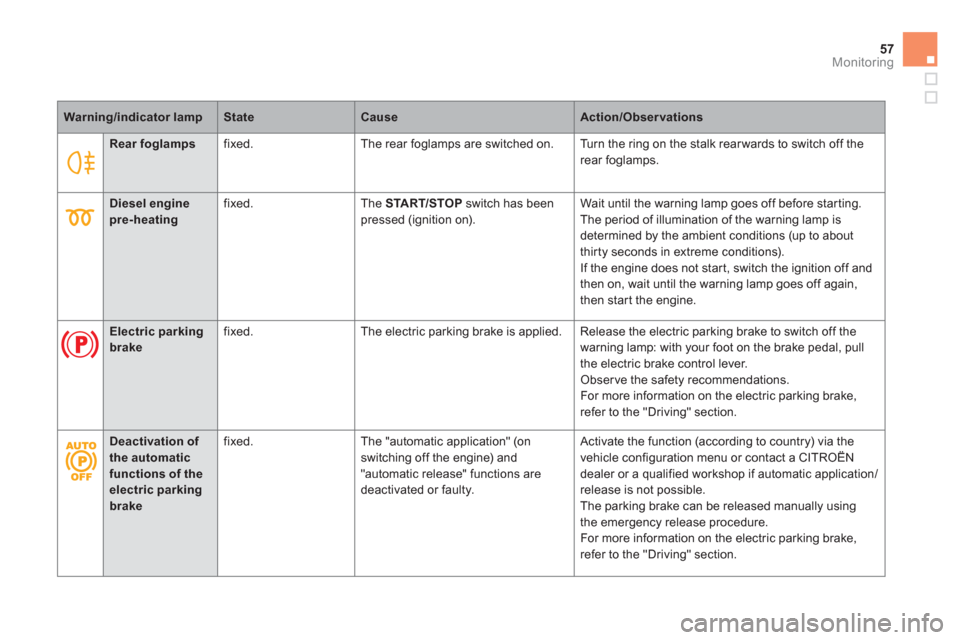
57
Monitoring
Rear foglamps
fixed. The rear foglamps are switched on. Turn the ring on the stalk rear wards to switch off the
rear foglamps.
Warning/indicator lampStateCauseAction/Observations
Diesel engine pre-heating fixed. The STA R T/STOP
switch has been pressed (ignition on). Wait until the warning lamp goes off before star ting.
The period of illumination of the warning lamp is
determined by the ambient conditions (up to about
thirty seconds in extreme conditions).
If the engine does not star t, switch the ignition off and
then on, wait until the warning lamp goes off again,
then start the engine.
Electric parking brake
fixed. The electric parking brake is applied. Release the electric parking brake to switch off the
warning lamp: with your foot on the brake pedal, pull
the electric brake control lever.
Obser ve the safety recommendations.
For more information on the electric parking brake,
refer to the "Driving" section.
Deactivation of the automatic functions of the electric parkingbrake
fixed. The "automatic application" (on switching off the engine) and
"automatic release" functions aredeactivated or faulty.
Activate the function (according to country) via the
vehicle configuration menu or contact a CITROËN
dealer or a qualified workshop if automatic application/
re
lease is not possible.
The parking brake can be released manually usingthe emergency release procedure.
For more in
formation on the electric parking brake,
refer to the "Driving" section.
Page 62 of 358
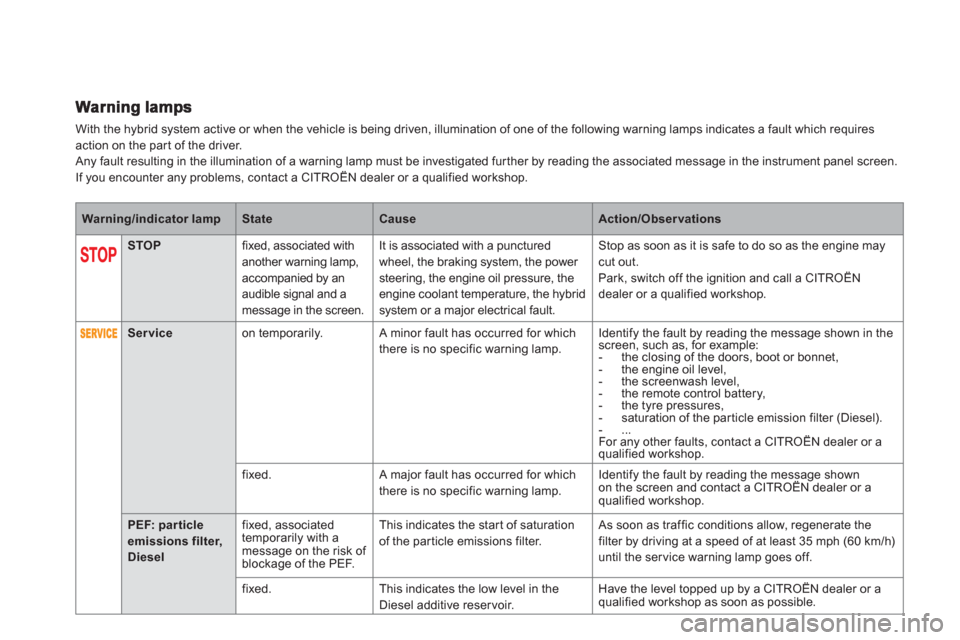
With the hybrid system active or when the vehicle is being driven, illumination of one of the following warning lamps indicates a fault which requires action on the par t of the driver.
Any fault resulting in the illumination of a warning lamp must be investigated further by reading the associated message in the instrument panel screen.
If you encounter any problems, contact a CITROËN dealer or a qualified workshop.
Warning/indicator lampStateCauseAction/Observations
STOPfixed, associated with another warning lamp, accompanied by an audible signal and a message in the screen.It is associated with a punctured
wheel, the brakin
g system, the power steering, the engine oil pressure, theengine coolant temperature, the hybrid system or a major electrical fault. Stop as soon as it is safe to do so as the en
gine may cut out.
Park, switch off the ignition and call a CITROËN
dealer or a qualified workshop.
Serviceon temporarily. A minor fault has occurred for which
there is no specific warning lamp. Identify the fault by reading the message shown in the screen, such as, for example:
- the closing of the doors, boot or bonnet,
- the engine oil level,
- the screenwash level,
- the remote control battery,
- the tyre pressures,
- saturation of the par ticle emission filter (Diesel). - ...For any other faults, contact a CITROËN dealer or a
qualified workshop.
fixed. A major fault has occurred for which
there is no specific warning lamp. Identify the fault by reading the message shown on the screen and contact a CITROËN dealer or a yyg g
qualified workshop.
PEF: particle emissions filter,Diesel
fixed, associated
temporarily with a message on the risk of
blockage of the PEF.Thi
s indicates the start of saturation
of the par ticle emissions filter. As soon as traffic conditions allow, regenerate the
filter by driving at a speed of at least 35 mph (60 km/h)
until the ser vice warning lamp goes off.
fixed.This indicates the low level in theDiesel additive reservoir. Have the level topped up by a CITROËN dealer or a
qualified workshop as soon as possible.